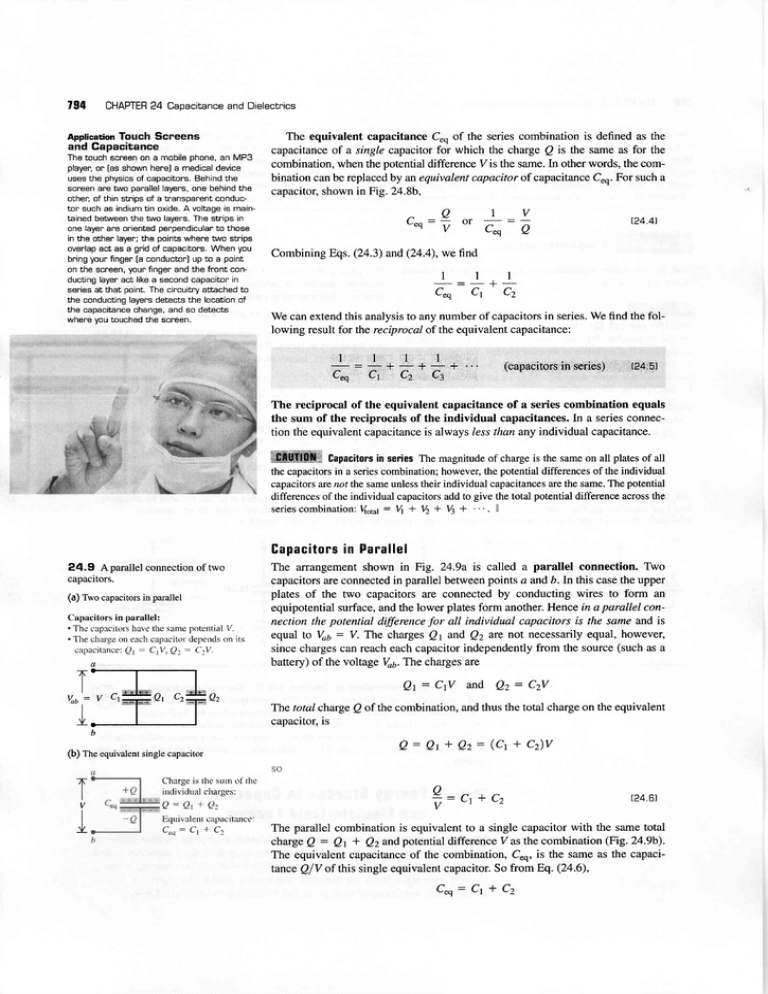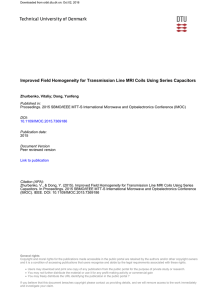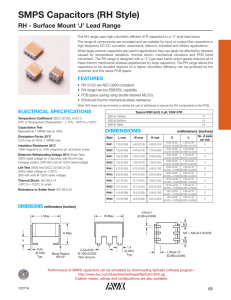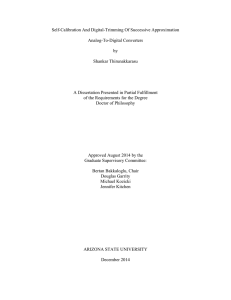| *f" I
advertisement

24 Capacitanceand Dielectrics
CHAPTER
794
Tauch $creens
Application
and Capacitance
The touch screenon a mobilephone,an MP3
playeqon [as shown here] a medicaldevice
uses the physicsof capacitors.Behindthe
screen are two parallellayers,one behindthe
other, of thin strips of a transparent conductor such as indiumtin oxide.A voltageis maintained betweenthe two layers.The strips in
one layerare orientedperpendicularto those
in the other layen;the points where two strips
overlapact as a grid of capacitors.When you
bring your finger [a conduclorJup to a point
on the screen,younfinger and the front conductinglayeract like a secondcapacitor in
series at that point.The circuitry attachedto
the conductinglayersdetects the locationof
the capacitancechange,and so detects
where you touchedthe screen.
The equivalent capacitanceC"q of'the seriescombinationis definedas the
capacitanceof a single capacitorfor which the charge Q is the sameas for the
combination,whenthepotentialdifferenceVis the same.In otherwords,thecombinationcanbe replacedby an equivalentcapncitorof capacitanceCeq.For sucha
capacitor,
shownin Fig.24.8b,
O
c"q:I
or
v
I
a*:
a
Q4.41
Eqs.(24.3)and(24.4),wefincl
Cornbining
l
_
lI
l
I
C.q
C1
C2
We can extend this analysis to any number of capacitors in series.We find the follcrwing result fbr the reciprocal of the equivalent capacitance:
,l
' 1 , ' ', 1
I . ,
- :
:- .Î ' ' - ' t * , " '
rC.q , ,
C2 ,l C . 3 :
t
(capacitors
in series)
"'
d'
t24.51
llhe reciprocal of the equivalent capacitanceof a series combination equals
the sum of the reciprocals of the individual capacitances.In a seriesconnecis alwayslessthan any individualcapacitance.
tion the equivalentcapacitance
l .ffi c a p a c i turei ngeri ssThemagni tudeofchargei sthesameonal l pl a t esof all
of theindividual
in a seriescombination;
however,thepotentialdifl'erences
thecapacitors
arethesame.Thepotential
capacitors
arenofthesameunlesstheirindividualcapacitances
acrossthe
addto givethetotalpotentialdifference
dil'ferences
of theindividualcapacitors
Vt.x"l: V + V2+ V3+ "' . U
series
combination:
Iag*citars in Y*ralls,l
t4.g
A parallel connection of two
capacitors.
(a) Two capacitorsin parallel
{.lrrpacitorsin parallel:
,'l'hs)capî(titi)r's
lr;wc'fhe sanrepotent.ialV.
.'['he chiirgeorl r'fichc;lpilcitordepencls
r:n its
clrl:tcitrtnce:
Q1 " C1V,Q:,. (.':.Y.
a
Tffi
l
|
l
" 1""
l
I
crff?z
vob',:
v ctffior
*f"
|
-ù-,
II
I
The arrangementshown in Fig. 24.9a is called a parallel connection. Two
capacitorsa.reconnectedin parallelbetweenpoints a andb. In this casethe upper
plates of the two capacitorsare connectedby conducting wires to form an
equipotentialsurface,and the lower platesform another.Hencein a parallel connection the potenîictldffirence .for aII índividual capacitors is the sameand is
equal to Y,u: V. The chargesQ1 and Q2 are not necessarilyequal,however,
sincechargescan reacheachcapacitorindependentlyfrom the source(suchas a
battery)of the voltageVo6.Thechargesare
Qt = CtV and Qz: CzV
The totul chargeQ of the combination,and thus the total chargeon the equivalent
capacitor,is
b
(b) fne equivalentsinglecapacitor
-'[-
II
v
I
I
_\z_
Chargeis tlresurnoi the
indiviclualcharges:
Q * Qr'r tl:
l'it1ui vlleut c:rpacítiurr:e:
g^".,==1', 1_(..,
vrl
Q : Q t + Q z : ( C r+ C ù V
O
i:t,
*Cz
t24.6)
The parallelcombinationis equivalentto a singlecapacitorwith the sametotal
chargeQ : Qr + Qz andpotentialdifferenceV as thecombination(Fig. 24.9b).
The equivalentcapacitanceof the combinatiofl, C"q, is the sameas the capacitanceQIV of this singleequivalentcapacitor.So from Eq. (24.6),
C"q:
C1 t
C2





